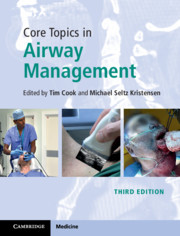Book contents
- Core Topics in Airway Management
- Core Topics in Airway Management
- Copyright page
- Contents
- Contributors
- Foreword
- Preface to the Third Edition
- Section 1 Airway Management: Background and Techniques
- Section 2 Airway Management: Clinical Settings and Subspecialties
- Chapter 22 The Airway in Obstetrics
- Chapter 23 The Paediatric Airway
- Chapter 24 Airway Management in Obesity
- Chapter 25 Maxillofacial and Dental Surgery
- Chapter 26 Ear, Nose and Throat Surgery: Airway Management
- Chapter 27 Lung Separation
- Chapter 28 Airway Management in the Critically Ill
- Chapter 29 The Patient with a Tracheostomy
- Chapter 30 Pre-hospital and Trauma Airway Management
- Chapter 31 Airway Management during CPR
- Chapter 32 The Bloody and Bleeding Airway
- Chapter 33 The Airway in Anaesthesia for Transoral Robotic Surgery
- Section 3 Airway Management: Organisation
- Index
- References
Chapter 29 - The Patient with a Tracheostomy
from Section 2 - Airway Management: Clinical Settings and Subspecialties
Published online by Cambridge University Press: 03 October 2020
- Core Topics in Airway Management
- Core Topics in Airway Management
- Copyright page
- Contents
- Contributors
- Foreword
- Preface to the Third Edition
- Section 1 Airway Management: Background and Techniques
- Section 2 Airway Management: Clinical Settings and Subspecialties
- Chapter 22 The Airway in Obstetrics
- Chapter 23 The Paediatric Airway
- Chapter 24 Airway Management in Obesity
- Chapter 25 Maxillofacial and Dental Surgery
- Chapter 26 Ear, Nose and Throat Surgery: Airway Management
- Chapter 27 Lung Separation
- Chapter 28 Airway Management in the Critically Ill
- Chapter 29 The Patient with a Tracheostomy
- Chapter 30 Pre-hospital and Trauma Airway Management
- Chapter 31 Airway Management during CPR
- Chapter 32 The Bloody and Bleeding Airway
- Chapter 33 The Airway in Anaesthesia for Transoral Robotic Surgery
- Section 3 Airway Management: Organisation
- Index
- References
Summary
Although the term ‘tracheostomy’ simply means a hole entering the trachea, it can be usefully divided into tracheostomy (in which a hole is made between the anterior neck and the trachea, which remains otherwise intact) and laryngectomy (in which the larynx is removed and the trachea is joined to the neck as a blind-ending stoma). Both groups of patients have an increased risk of complications outside and within hospitals. Many of these are entirely avoidable by better knowledge and reliability of care. There is confusion about different types of tracheostomy and between management of complications of tracheostomy and laryngectomy stoma. There is a need for clear understanding of the differences and what represents good care of such patients and their airways. Complications include airway blockage and displacement. Harm may occur if airway emergencies are not managed promptly and in a structured manner. Standard operating procedures, algorithms and checklists have a role in improving reliability of care and approaches to emergencies. Recent evidence shows multidisciplinary teams using quality improvement principles can reduce complications, hasten decannulation and improve patient experience. The National Tracheostomy Safety Project and the Global Tracheostomy Collaborative have been established to improve education and safety of tracheostomy care.
Keywords
Information
- Type
- Chapter
- Information
- Core Topics in Airway Management , pp. 259 - 269Publisher: Cambridge University PressPrint publication year: 2020
